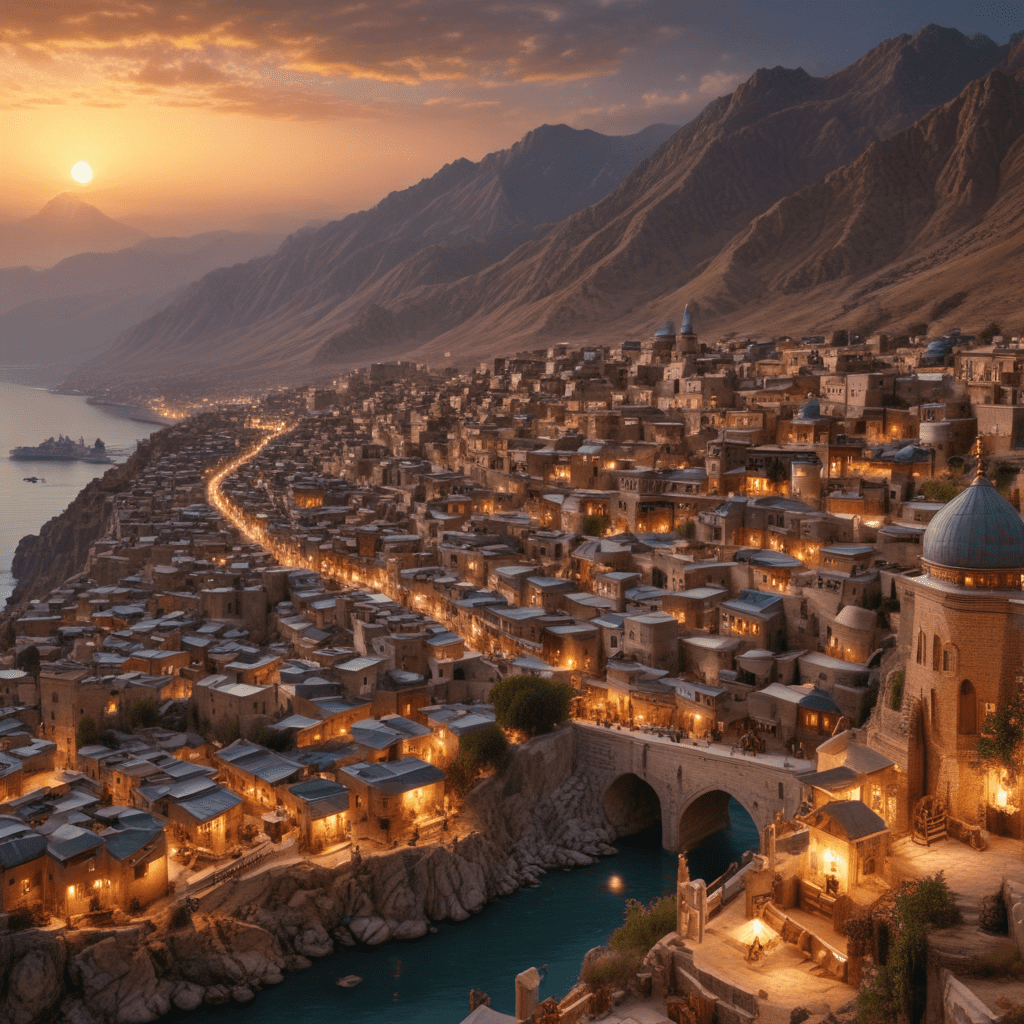Paradise Lost: The Sunken City of Ahriman
Nestled amidst the rugged peaks of the Alborz Mountains lies a tale whispered in hushed tones – the legend of Ahriman, the sunken city swallowed by the earth's wrath. In the heart of ancient Persia, amidst the cradle of civilization, this mythical metropolis once flourished, a testament to the hubris of its inhabitants.
Ahriman, the embodiment of darkness and evil in Zoroastrian lore, played a pivotal role in the city's demise. Legends recount how the citizens of Ahriman grew arrogant, indulging in excess and neglecting the sacred principles of their faith. Their impiety incensed Ahura Mazda, the benevolent creator god, who unleashed his fury upon the city. The earth trembled, the sky turned ashen, and in an earth-shattering cataclysm, Ahriman was consumed by the yawning abyss, its inhabitants condemned to an eternity beneath the unforgiving sands.
This cautionary tale echoes through the ages, reminding us of the ephemeral nature of earthly glory and the consequences of straying from the path of righteousness. The legend of Ahriman serves as a poignant reminder that true prosperity lies not in material abundance but in living in harmony with the divine order.
City of the Jinn: The Hidden Metropolis of Shahr-e Gandom
Shrouded in the ethereal embrace of the desert lies Shahr-e Gandom, the hidden city of the Jinn, a mythical metropolis veiled in mystery and wonder. Legends whisper of its shimmering walls built from golden wheat, a testament to the Jinn's mastery over the elements. Within this enigmatic realm, the Jinn are said to dwell, creatures of fire and air, possessing supernatural powers and knowledge beyond the grasp of mortals.
Shahr-e Gandom exists in a realm parallel to our own, accessible only through hidden portals or by those deemed worthy by the Jinn themselves. Tales abound of travelers stumbling upon the city by chance, lured by the intoxicating fragrance of freshly baked bread or the melodious strains of unseen musicians. Those who enter are said to find a world unlike any other, where time flows differently, and the boundaries between reality and illusion blur.
The legend of Shahr-e Gandom is a testament to the rich tapestry of Persian mythology, where the line between myth and reality blurs, leaving us to wonder if this hidden metropolis truly exists or resides only within the realm of imagination.
Glowing with Gold: The City of Dehqan and the Myth of Kay Kavous
In the heart of the ancient Persian Empire, where the sun-drenched plains meet the towering mountains, lies the fabled City of Dehqan, its streets paved with pure gold and its walls adorned with jewels that shimmered under the desert sun. This mythical metropolis is said to have been the seat of Kay Kavous, a legendary king renowned for his wisdom, power, and ambition.
Legends recount how Kay Kavous, yearning to ascend to the heavens and converse with the gods, built a magnificent throne adorned with precious gems and had four eagles trained to carry it skyward. His audacious journey, however, ended in disaster as the eagles, overwhelmed by the heat of the sun, released their grip, sending Kay Kavous plummeting back to earth. Though he survived the fall, his ambition was humbled, and the City of Dehqan, once a symbol of his grandeur, faded into myth and legend.
The tale of Kay Kavous and the City of Dehqan serves as a cautionary reminder of the dangers of unchecked ambition and the consequences of defying the natural order. It reminds us that true greatness lies not in material possessions or earthly pursuits but in humility, wisdom, and a reverence for the divine.
Lost City of Fire: The Tale of Siavash and the Burning Citadel
Amidst the desolate wastelands of the Dasht-e Kavir, where the relentless sun scorches the earth, lies the lost city of Siavash, a tale etched in the annals of Persian mythology. This once-magnificent citadel, reduced to smoldering ruins, stands as a testament to the tragic demise of Siavash, a prince renowned for his righteousness and unwavering loyalty.
Siavash, falsely accused of treachery by his jealous stepmother, was forced to undergo a trial by fire to prove his innocence. Undeterred by the flames, he emerged unscathed, his purity evident to all. However, the ordeal had taken its toll, and Siavash, heartbroken by the betrayal of those closest to him, left Persia, seeking refuge in a distant land. There, he established a new kingdom, but his peace was short-lived. His enemies, consumed by vengeance, pursued him, setting his new city ablaze, reducing it to ashes.
The tale of Siavash and the burning citadel is a poignant reminder of the destructive consequences of envy and betrayal, and the enduring legacy of courage and integrity in the face of adversity.
Whispers of the Wind: The Legend of Bam and the City of 100 Gates
In the southeastern reaches of Persia, where the wind whispers tales of ancient times, lies the legendary city of Bam, once known as the "City of 100 Gates." This ancient metropolis, nestled at the foot of a towering mountain range, was a hub of trade and culture, its massive walls adorned with intricate carvings and its gates opening to travelers from across the known world.
Legends recount how the city's prosperity was attributed to its wise and benevolent ruler, who governed with fairness and justice. Under his reign, Bam flourished, becoming a center of learning, art, and commerce. The city's hundred gates symbolized its openness to the world, welcoming visitors from far and wide. However, fate had a cruel twist in store. A devastating earthquake, striking without warning, reduced the once-magnificent city to ruins. The gates, once symbols of welcome and prosperity, lay shattered, their echoes lost in the wind.
The legend of Bam and the City of 100 Gates serves as a poignant reminder of the impermanence of earthly glory and the capricious nature of fate. It is a tale that echoes through the ages, reminding us to cherish the present moment and to build our lives on a foundation of wisdom, compassion, and justice.
6. Beneath the Waves: The Myth of the Submerged City of Marv
In the heart of the vast Lut Desert, where the sun's relentless heat scorches the land, lies a tale whispered beneath the sands – the legend of the submerged city of Marv. This mythical metropolis, once a thriving oasis city, is said to have vanished beneath the waves of an ancient sea, swallowed by the wrath of nature.
Legends recount how Marv was a city of unparalleled beauty and prosperity. Its fertile lands yielded abundant harvests, its bustling markets overflowed with riches, and its grand palaces echoed with the laughter of its content inhabitants. However, the citizens of Marv grew arrogant, forgetting the importance of humility and gratitude. They turned away from the gods, indulging in lavish lifestyles and neglecting the sacred principles of their faith.
Enraged by their impiety, the gods unleashed their fury upon Marv. The ground trembled, the sky turned crimson, and in a cataclysmic event, the city was swallowed by a newly formed sea. In the blink of an eye, Marv and its inhabitants vanished beneath the waves, leaving behind only a haunting legend and a vast expanse of water known as Lake Hamun.
The tale of the submerged city of Marv serves as a cautionary reminder of the ephemeral nature of earthly glory and the consequences of straying from the path of righteousness. It teaches us that true fulfillment lies not in material possessions but in living in harmony with nature and honoring the divine order.
7. City of the Moon: The Mysterious Citadel of Manizheh
In the ethereal realm of Persian mythology, where the boundaries between dreams and reality blur, lies the City of the Moon, a celestial metropolis veiled in an aura of mystery and wonder. This mythical citadel, said to reside on the moon's surface, is the dwelling place of Manizheh, a beautiful and enigmatic queen revered for her wisdom and healing powers.
Legends recount how Manizheh, a princess of unparalleled beauty and compassion, was banished from her earthly kingdom by her jealous stepmother. Seeking refuge amongst the stars, she found solace on the silvery surface of the moon, where she established her celestial abode. In this ethereal realm, Manizheh became a beacon of hope and healing, using her extraordinary powers to guide lost souls, mend broken hearts, and alleviate suffering.
Though the City of the Moon remains hidden from mortal eyes, its presence is said to be felt on earth through the soft glow of moonlight and the whispers of the night wind. The myth of Manizheh and her celestial citadel serves as a testament to the enduring human yearning for compassion, solace, and a connection to the divine.
8. Echoes in the Desert: The Lost City of the Simurgh
In the desolate expanse of the Dasht-e Lut, where the sun's relentless heat distorts reality, lies the haunting echo of a lost city – the legendary abode of the Simurgh, a mythical bird of wisdom and immortality. This enigmatic creature, revered for its profound knowledge and transformative power, is said to dwell in a hidden oasis amidst the unforgiving desert.
Legends recount how the Simurgh is a benevolent being, guiding lost souls, offering counsel to those who seek its wisdom, and aiding those on their spiritual journeys. Its majestic form, often depicted as a giant bird with the head of a dog and the talons of a lion, symbolizes the integration of intuition, strength, and spiritual insight.
The lost city of the Simurgh represents the pursuit of enlightenment and self-discovery. It serves as a beacon of hope for those who yearn for deeper understanding and a connection to the divine. Though its location remains obscured, the echoes of its legend resonate through the ages, guiding those who dare to venture into the depths of the unknown.
9. Gateway to the Underworld: The Myth of the Tunnel City of Afrasiab
In the ancient city of Samarkand, nestled amidst the fertile plains of Uzbekistan, lies a hidden portal to the underworld – the mythical Tunnel City of Afrasiab. This subterranean metropolis, shrouded in an aura of mystery and intrigue, is said to have been the dwelling place of a powerful sorcerer named Afrasiab, who ruled over a vast underground kingdom.
Legends recount how Afrasiab, a descendant of Tur, the evil king of Turan, possessed extraordinary magical abilities. He commanded legions of djinn, demons, and other supernatural creatures, using their power to expand his subterranean domain. The Tunnel City of Afrasiab was said to be a labyrinth of interconnected tunnels and chambers, filled with treasures both wondrous and perilous. Those who dared to venture into its depths risked encountering mythical beasts, powerful spells, and the wrath of Afrasiab himself.



